Talking about the baby
• How was the visit to the pregnant woman?
• Have you been able to talk to her about what we have seen/learned up to now?
• Is there any doubt that could be now clarified?
• Is there any message, prayer, or bible quotation celebrating the gift of life and the actions we have performed to our next, to the pregnant women and to their families? A suggestion is:
“And then he said to them, 'Anyone who welcomes this little child in my name welcomes me; and anyone who welcomes me, welcomes the One who sent me. The least among you all is the one who is the greatest.'” Luk 9:48
To See
The pregnant woman in the fourth, the fifth and the sixth pregnancy months
1. What do the pregnant women of their community most like to know in this stage?
2. Do the pregnant women in their community receive the Pregnant Woman’s Card after they do the Prenatal check?
Alinhada à esquerda - vertical
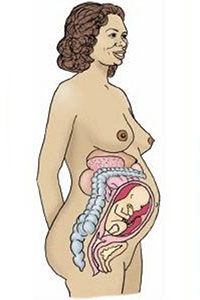
Foto:
The baby moves even more in the womb. In the end of the fourth month he/she is about 10 to 20 centimetres high and weights approximately 220 grams.
In the fifth month, the baby sucks the fingers and makes faces. Opens and closes the eyes and moves the hands and feet. In this month the baby grows a lot and may reach the 25 centimetres and weigh up to 500 grams.
In the sixth month, the hearing, the smell, the touch and the taste senses develop in the baby. The sight is the last of the senses to develop. The baby already reacts to the external stimulus such as to light and to music and also perceives the physical noises of the mother such as the beat of her heart.
The baby reacts to other voices besides the voice of the mother. The parents may pray and sing close to the baby. If they have other kids it is good to encourage them to talk to the little brother/sister and cuddle the belly of the mother. This increases the link between the family and the baby.
Talking about the pregnant woman
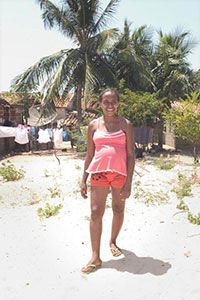
Foto:
In this quarter the pregnant woman feels better and happier because her body is already used to the changes caused by pregnancy.
In this phase it is common to appear a dark line under the tummy that goes till the belly bottom. Some dark stains may appear on the face. For these stains not to increase it is recommended that the pregnant woman protect her face from the sun with a hat, cap or umbrella.
In the fifth month the future mother begins to feel that the movements of the baby every time now are stronger. The baby begins to have a longer period of activity in certain times of the day and also some periods of rest during the day.
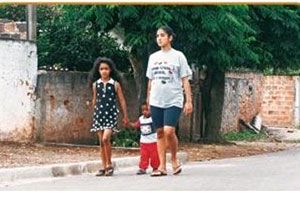
Foto:
In the sixth month the belly is showing well. Every month the pregnant woman increases a little the weight. If she grows too much she may have pains in the back, besides having grooves in the breasts and the belly. When the grooves itch it is recommended that she make a paste of flour or tapioca flour/talcum (starch) and a little water and pass on it.
It is advisable that the parents keep on talking to the baby. When this is not the first child it is recommended to get the other children involved in this conversation. Thus, the kids will be able to understand and accept better the arrival of the new brother/sister – and this will help to prevent him/her/them to feel rejected or abandoned after the baby is born.
During the pregnancy period some couples feel their sexual desire increase and some feel little or no sexual desire at all.
The couple may continue to have sexual intercourses. They shall only be avoided when the pregnant woman has bleeding, liquid loss or strong pain.
“Let love be without any pretence. Avoid what is evil; stick to what is good. In brotherly love let your feelings of deep affection for one another come to expression and regard others as more important than yourself.” Rom 12: 9-10
Breastfeeding
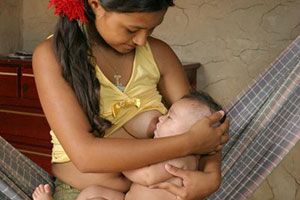
Foto:
Leader, keep on talking to the pregnant woman and with her family about breastfeeding. Explain that breastfeeding is the healthiest, cheapest and simplest way to feed the baby.
The breast milk contains everything the baby needs to grow apart from the substances (antibodies), which protect him/her from diseases. Feeding the child with cow milk or with canned milk may bring the risk of contamination and of wrong preparation. Therefore this risk plus the lack of antibodies may harm the baby´s health.
When the baby is only breastfed he/she gets more body defences against pneumonia, diarrhea and pain in the ear.
Most common complaints

Foto:
Gases, bad digestion and heartburn
This occurs because the womb grows and pulls the stomach back and the intestine making it difficult for the food digestion. It is advisable that the pregnant woman pay attention to the food which causes her to have bad digestion and then avoid it. Besides that in order to avoid these disorders it is important to have healthy eating habits with regular meals. Parsley, ginger and anise tea help to reduce the gases.
For a good digestion it is recommended to:
• Give preference to fresher food;
• Eat fibres rich food found in vegetables and fruit, rye and wheat among others
• Avoid sweets, black tea, “Paraguay” tea (from an evergreen bush), coffee, and soft drinks because they provoke gases and heartburn;
• Eat slowly, chewing the food very well;
• Avoid eating fat food or very dry food;
• Drink a lot of liquid between the meals avoiding the very hot or icy liquids;
• Eat a little each time;
• Eat every three hours;
• Avoid remain sitting or lying down for too long.
Leader, if the pregnant woman has heartburn, instruct her not to drink cold milk as a medicine, not to lie down soon after the meals and sleep with high pillow.

Foto:
Swollen state, varicose veins or cramps
During pregnancy it is common that the feet get swollen. Some varicose veins may appear in the legs or in the vagina. This happens because the womb weighs more and prevents the blood circulation.
To increase blood circulation it is recommended that the pregnant woman wear loosen clothes and eat food with little salt. The discomfort of varicose veins and swollen feet diminish when the pregnant woman walks and whenever she sits or lies with the legs up.
It is advisable to avoid socks or panties with tight bands and shoes with slippery soles.
Cramps appear when the pregnant woman moves little and when there is a lack of some salts in her body. In order to reduce the cramps the pregnant woman shall sit down, stretch her legs and pull her feet toes up with her hands. To make massages and avoid staying longer periods in the same position also help.
Coconut water, banana, orange and beans help to prevent the cramps.
Haemorrhoids
Haemorrhoids are varicoses that appear in the end of the bowels. The pregnant woman may also complain about constipation. If the bowels do not work properly everyday the haemorrhoids get worse and may bleed.
For the bowels to evacuate properly it is recommended to drink a lot of liquid, make walks and to eat more fibres such as fruit and vegetables.
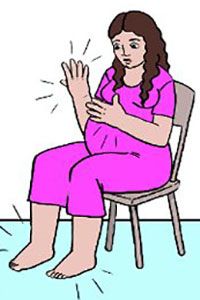
Foto:
Vaginal discharge
The hormones of pregnancy may cause a white discharge. In order to clean this discharge the pregnant woman needs to wash just the external part locally and dry it very well.
When the pregnant woman complains of a vagina discharge with itch and odour she needs to seek for a doctor, do the physical tests and receive adequate treatment. Sometimes the doctor also prescribes medicine to the partner. When the treatment is correctly followed the complaints soon stop.
Swollen body and high blood pressure
If, in the early morning the pregnant woman has headache or has the face, feet and hands swollen it is necessary to take her to the Health Service immediately.
High blood pressure, loss of protein through the urine and swollen body are signs of pre-eclampsia. This problem may be solved with more care in the prenatal checks, rest and medicines. Sometimes it is necessary to be treated in the hospital.
If the pregnant woman does not receive proper treatment this can get worse and have convulsions. In this phase we call the disease eclampsia, a serious problem that may bring risk to the life of the pregnant woman and for the baby.
Diabetes
Diabetes occurs when there is an increase of sugar in the blood (Glucose). The most common signs are:
• Extreme thirst;
• Increase in the amount of urine;
• Fatigue, weakness, dizziness;
• Blurred sight;
• Appetite increase;
• Weight loss;
In pregnancy two situations may occur regarding diabetes:
Either the woman had already diabetes when got pregnant; Or she gets diabetes because of pregnancy: the disease has appeared the first time during pregnancy.
In these situations it required more attention in the pre-test check. Watching for the food intake and doing physical exercises help to control the disease. Sometimes it is necessary to take medicine.
The treatment for the control of diabetes is made through checks throughout pregnancy. After the baby is born it is necessary to make new checks to see how the health of the mother is.
“Son, if you get sick do not overlook it, pray to the Lord and He shall heal you. And seek for the doctor for the Lord also created him. And he shall not go away from you for you are in need of his services” Ecc 38:9-12
The Pregnant Woman’s Card
The Pregnant Woman’s Card has important information for the health record of the pregnant woman and of her child. It is a right she is entitled to and it must be given to her at her first prenatal check. The pregnant woman shall bring her card in all her medical appointments.
On this Pregnant’s Card are recorded the diseases prior to the pregnancy, the data of the current pregnancy and of the baby’s growth, the results of the checks and the scheduling of the appointments.
Leader, during the visits you make, always ask to see the Pregnant’s Card and watch for:
• How updated the vaccination against tetanus is (see page 56 of this Guide);
• The pregnancy week; (A)
• If the pregnant woman has been weighed (B); and if her blood pressure has been taken (C);
• If the measure of womb height has been taken (D) ( see page 74);
• If the womb height curve has been filled, according to the pregnancy stage.

In the following checks it shall be recorded the:
A - blood type and if the RH factor is positive or negative; B- blood test result for anemia; C- blood test result for diabetes; D- blood test result for syphilis; E- urine test result to diagnose urinary infection; or protein loss; F- blood test result for HIV/Aids; G- blood test result for hepatitis B; H- blood test result for toxoplasmosis.

In the home visit, the leader shall look at the Pregnant’s Card and encourage her to do the prenatal check for it is at this point that many of the pregnancy’s future complications can be prevented.
Assessing the baby’s growth
It is expected that the baby grow every month during pregnancy. To follow up this growth, the measurement of the womb height can be used. This is made in the prenatal checks. This measurement must be noted down in the Pregnant Woman’s Card according to the pregnancy week.

This data may be noted down in two fields in the Pregnant Woman’s Card:
inside the card which refers to the actual pregnancy shall be noted the womb height in centimetres; in the cover of the card where the percentile curves (P10 and P90) are found: the womb height curve Graphic/ pregnancy stage.

When the baby grows less than the expected
In the womb curve graphic, when the measure is under the P10 curve, the baby is growing less than the expected.
This can be caused by the mother’s malnutrition, high blood pressure, smoking habit, anemia and other factors.

When the baby grows above the expected
The growth can be above the P90 curve when the pregnant is expecting twins, has diabetes or caused by other factors.
Leader, it is a right of the pregnant woman to have her womb height measured and noted down in the Pregnant Woman’s Card during the prenatal checks.
Where the measurements have not been noted down yet, it is recommended that you talk to the health service professionals to show them that you can cooperate with them in health fostering.

In such cases, the pregnant woman needs more care from you, the leader, and from the prenatal medical doctor.

Signs of danger throughout pregnancy
It is important that the pregnant woman and her family know how to identify the signs of danger throughout pregnancy. Leader, instruct the family to look for a hospital immediately if the pregnant woman shows some of these signs:

Attention: From the seventh pregnancy month also observe: The baby who does not move or the baby who agitates very much.
Prepare an emergency plan together with the pregnant woman and her family in case some signs of danger are noticed:
• How to take the pregnant woman with signs of danger to the hospital?
Write the address and telephone of the hospital.
• Who can accompany this pregnant woman? How can her partner be notified?
• Who can take care of the other pregnant woman’s children until she can return home?
Home Visit
While doing these visits it is important to:
Ask if the pregnant woman has some complaint or concern in this pregnancy phase and how you can help;
Talk about the signs of danger;
Deliver and read with the pregnant woman the Love Bonds Card of her current pregnancy month;
Answer the Leaders’ Notebook questions..
Task suggestion for this qualification stage:
Leader, visit a pregnant woman you have registered in your community:
Observe how is the baby’s growth through the pregnant woman’s womb height growth curve;
Fill the emergency plan for the pregnant woman.



